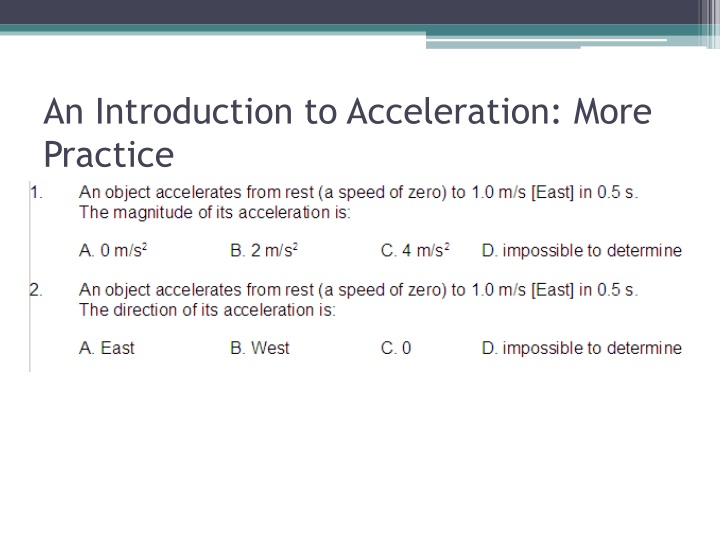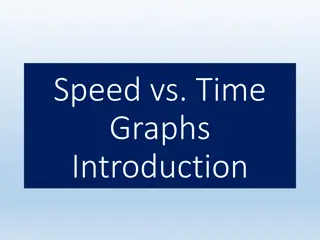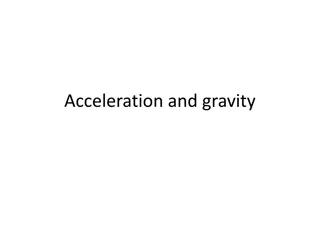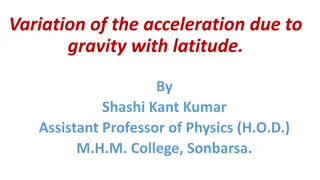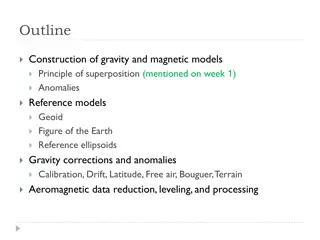Acceleration and Gravity in Physics
Explore the concepts of acceleration and gravity in physics through engaging images and key points. Learn about mass, weight, Newton's Law of Gravitational Attraction, and the acceleration due to Earth's gravity. Discover how all objects fall at the same rate regardless of mass and what factors can influence acceleration.
Download Presentation

Please find below an Image/Link to download the presentation.
The content on the website is provided AS IS for your information and personal use only. It may not be sold, licensed, or shared on other websites without obtaining consent from the author.If you encounter any issues during the download, it is possible that the publisher has removed the file from their server.
You are allowed to download the files provided on this website for personal or commercial use, subject to the condition that they are used lawfully. All files are the property of their respective owners.
The content on the website is provided AS IS for your information and personal use only. It may not be sold, licensed, or shared on other websites without obtaining consent from the author.
E N D
Presentation Transcript
Read Going Ballistic Key Points: There is gravity between all objects with mass Whenever we throw an object, it travels in a parabola If it never hit the ground, the shape would be an ellipse
Definitions Mass the amount of matter in an object Measured in kg Weight The amount of gravitational force acting on an object Measured in N
Newtons Law of Gravitational Attraction Gm m = 1 2 Fg 2 d There is a force of gravity between any two objects with mass Larger distance between them, smaller force
g = 9.8 m/s2 [down] The acceleration due to the Earth s gravity is 9.8 m/s2 [down]. The magnitude of this acceleration is denoted by the letter g. 32 = 1
Do all objects fall at the same rate? Is there anything that can affect the rate they accelerate?
Mass doesnt matter No matter what your mass, everything falls at the same rate if we ignore air resistance Galileo is attributed with this discovery Video
Drag However, some objects are slowed by atmospheric drag more than others.
Terminal velocity At a given speed, the drag will equal the gravity, and the object will stop accelerating, i.e. reach terminal velocity.
Terminal velocities Typical terminal velocities: Human Human with parachute Dandelion seed 53 m/s (190 km/h) 5 m/s (18 km/h) 0.5 m/s (1.8 km/h)
The fastest man On August 16th, 1960 U.S. Air Force Captain Joe Kittinger broke the sound barrier (1240 km/h) during a free-fall from the high altitude balloon Excelsior III, at an altitude of approximately 31 km.
Highest fall survived (without a parachute) Flight attendant Vesna Vulovi fell 10,000 m on January 26, 1972 when she was aboard a plane that was brought down by explosives over the Czech Republic. She suffered a broken skull, three broken vertebrae (one crushed completely), and was in a coma for 27 days, but she survived!
gs Accelerations are often given in terms of g. For example, 1 . g = m s 49 5 g 2 m s 98 2
Blackout A typical person can handle about 5 g before loss of consciousness, blackout, occurs. The record for the most g forces on a roller coaster belongs to Mindbender at Galaxyland Amusement Park in Edmonton, Alberta, at 5.2 g.
Greyout Through the combination of special g- suits and efforts to strain muscles both of force blood back into the brain modern pilots can typically handle 9 g or more. They may experience a greyout (temporary loss of colour vision, tunnel vision, or an inability to interpret verbal commands) between 6 and 9 g.
Negative gs Resistance to "negative" or upward g s, which drive blood to the head, is much less (typically in the -2 to -3 g range). During redout, vision goes red, probably due to capillaries in the eyes bursting under the increased blood pressure.
g-Force Acceleration perpendicular to the spine is more tolerable. Acceleration pushing the body backwards ( eyeballs in ) is tolerable up to 17g, andpushing the body forwards ( eyeballs out ) up to 12g.
Strongest g-forces survived Voluntarily: Colonel John Stapp in 1954 sustained 46.2 g in a rocket sled, while conducting research on the effects of human deceleration
Strongest g-forces survived Involuntarily: Formula One racing car driver David Purley survived an estimated 178 g in 1977 when he decelerated from 173 km/h to 0 in a distance of 66 cm after his throttle got stuck wide open and he hit a wall
Everyday g-forces Coughing: 3.5 g Sneezing: 2.9 g
Free fall Objects in free-fall feel 0 g, or weightlessness. There is no such thing as zero gravity, gravity acts on you everywhere in the universe
On Earth, Fg = mg Where, Fg Force of Gravity (N) m mass (kg) g Gravitational Field Strength (N/kg) or acceleration due to gravity (m/s2) g = 9.8 m/s2 [down] or 9.8 N/kg[down]
Example: Andrew has a mass of 68 kg, what is his weight?
Homework Gravitational field strength worksheet
